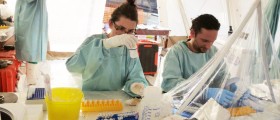
Smallpox is a highly infectious disease which occurs only in humans. According to the experts, there are two main causes of this disease and they are both viruses called Variola major and Variola minor. Apart from the name smallpox, there are some other names like Variola or Variola vera. These names come as a derivate from Latin, because varus means spotted. Term smallpox was used for the first time during the 15th century in order to distinguish variola from the great pox.
Classification: Two clinical forms of smallpox
The experts have clinically divided smallpox into two forms. These forms are Variola major and Variola minor. A person who suffers from Variola major will experience an extensive and severe rash and an extremely high fever. On the other hand, Variola minor is not nearly as common as Variola major. According to the data, death rates of Variola minor are not even as high as 1%. Apart from these two forms, the experts have also noted a certain subclinical or asymptomatic infection with the variola virus. However, this type of infection is not that common. Vaccination is a common way of preventing smallpox and it is very effective. However, there are cases when a person does suffer from the virus and in most cases person is suffering from variola sine eruption or otherwise known as smallpox without rash. This form of smallpox is not easily diagnosed and can only be properly diagnosed by antibody studies. In some cases even virus isolation is used for the confirmation. The main characteristic of this form of smallpox is a high fever which occurs after the usual incubation period.
Signs and symptoms
According to the doctors, the first signs of smallpox which are obvious to everyone are usually seen 12 days after a person has been infected with the virus. This period is also known as the incubation period. Due to the fact that variola major virus enters the body through inhalation in almost all cases, it will attack the mouth and the throat or the respiratory mucosa before it will multiply and move on to the lymph nodes. The cases where the virus is not found in large numbers around the 12th day are extremely rare. Around the 12th day the virus will start to multiply on spleen, bone marrow and lymph nodes. The first obvious signs of smallpox are not that different from those seen in cases of influenza and the common cold. The most commonly seen symptoms are a fever of at least 38.5 °C, pain in the muscles, malaise, headache and prostration. Apart from these, nausea and vomiting are pretty common as well due to the fact that the digestive tract is affected as well. The experts claim that the pre-eruptive stage lasts for a period of no more than 4 days. When a person has reached the 12th day, first lesions are usually seen. These lesions look like small spots red in color and are called enathem. Enathem usually occur on mucous membranes of the mouth, tongue, palate and throat. When they appear, the temperate goes away in almost all cases. The lesions are known to grow fats and rupture. Due to this rupture the virus is able to enter the saliva. Variola virus attacks the skin cells and due to that this disease is associated with characteristic pimples otherwise known as macules. Macules first appear on the forehead but progress all over the body after that. The data claims that in the past smallpox used to be quite fatal and the rate of it was around 30%.
Cause and transmission of smallpox
Variola virus is the known cause of smallpox. This virus is shaped like a brick and it is large in size. There are four orthopoxviruses which cause the infection in humans. These are variola, vaccinia, cowpox and monkeypox. Variola infects only humans in nature but three other viruses can infect both humans and animals in nature. Transmission usually occurs through inhalation of the virus which can remain in the air. A person is infected when he or she gets in contact with the droplets of an infected person. However, in order to get infected, there is need of a prolonged face-to-face contact. Apart from this way of transmission, the virus can also spread through direct contact with bodily fluids or contaminated objects like bedding or clothing.
According to the data, variola major is known to be fatal in almost 35% of all cases while variola minor causes death in no more than 1%. Characteristic scars appear in between 65 and 85% of all cases. Blindness and deformity of the limbs are possible as well but these complications occur in no more than 5% of all cases. Until the vaccine was discovered up to 60% of patients diagnosed with smallpox died because of the disease.

















Your thoughts on this
Loading...